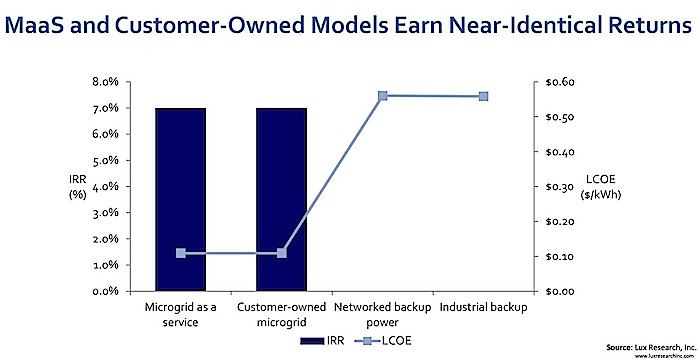Microgrid-As-A-Service & Other Alternatives To Conventional Macrogrids
Originally posted on the ECOreport
Though customer-owned microgrids will be the dominant ownership model in the near-term, a recent study by Lux Research Associate Dean Frankel shows that Microgrid-as-a-Service (MaaS) offers flexible ownership structure that attracts third party investors and is the best opportunity for power service providers and financiers to capitalize on this growing market.
Frankel said that there are a variety of microgrid applications which can meet varying levels of power services for depending upon the customer requirements.
Microgrids can increase energy security and reliability to support critical loads, but can also be implemented at smaller scales to bring power to areas that would not otherwise receive power. Frankel’s report mentions Mera Gao Power, which runs profitable solar-driven microgrids, in India, which serve 25-30 paying customers per microgrid installation. Small scale pay-as-you-go microgrid installations like these can profitably serve the 1.3 billion people who lack access to electricity. The pay-as-you-go off-grid market saw its first exit last week when Impact Energies was acquired by Persistent Energy Partners. The acquisition shows that on the ground execution in hard to reach markets will enable pay-as-you-go providers to see scaling benefits.
In the US, Frankel said there is increasing traction for “islandable microgrid architectures” which can be individual homes and businesses that combine solar power with a battery or thermal generation back-up system that will allow grid-connected homes to selectively disconnect from the grid when price signals or macrogrid outages support it NRG, for exampleis developing a gas powered generator paired with a solar system, while companies like SolarCity are using lithium-ion batteries thatwith an hour of energy storage capacity.. Frankel says that in emergency situations owners can extend this time limit by shutting off unnecessary applications.
Microgrids economic returns are regionally are impacted by electricity and gas prices. Every 1 cent per kilowatt-hour increase in electricity rate translates into a 2% increase in IRR. Similarly, gas price fluctuations can drastically swing microgrid economics – a 50% price increase from $4 to $6/mmBTU can completely wipe out any economic benefits of a microgrid implementation
Though there is sometimes friction between utility companies and their rooftop solar customers who are feeding the grid, some utility companies are financing residential Microgrid-as-a-Service (MaaS) products. A good example of this is the partnership between Sunverge Energy and Sacramento Municipal Utility District in California.
Microgrids also provide a back-up for emergency usage, when the grid goes down. They are necessary feature in hospitals and other sectors that must stay open.
The nation’s first commercial scale solar and energy storage microgrid was installed in Konterra realty’s corporate headquarters, in Maryland, last summer. It is a combined solar/solar grid storage system that can also feed the grid during an emergency.
Customer-owned microgrids and MaaS yield similar returns – but to different parties. Based on an industrial base case, with 10 MW of generation from solar and natural gas, as well as energy storage, the returns for the customer-owned microgrid and MaaS are identical. However, the customer-owned model places all financial risk on the customer, while the MaaS model offers an opportunity for utilities and third-party financiers to strategically capture customers while diversifying from traditional power service opportunities. Frankel says the MaaS model may be the best way to capitalize on this growing market, offering communities the enhanced reliability of a microgrid and investors a profit.
Frankel‘s report, “Microgrids: How Business Model Innovation Will Support New Development Opportunities,” is part of the Lux Research Grid Storage Intelligenceservice.
(Image at top of page: MaaS and Customer-Owned Models Earn Near-Identical Returns – Courtesy Lux Reseach, Inc)
Sign up for CleanTechnica's Weekly Substack for Zach and Scott's in-depth analyses and high level summaries, sign up for our daily newsletter, and follow us on Google News!
Sign up for our daily newsletter for 15 new cleantech stories a day. Or sign up for our weekly one on top stories of the week if daily is too frequent.
CleanTechnica uses affiliate links. See our policy here.
CleanTechnica's Comment Policy
